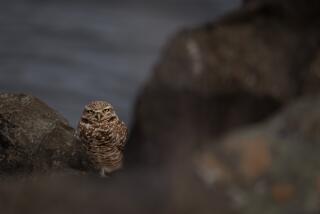Attractive male turkeys use their genes better, study says
What makes a female turkey swoon? The secret isn’t better genes, but better use of them, according to a new study.
In most cases, the more masculine a male’s physical traits, the more attractive he is to females. But why are some males more masculine than others, even when they’re brothers with similar DNA? Could the answer have to do with epigenetics: how genes are expressed -- turned on or turned off -- in different individuals?
Researchers at Oxford University and University College London turned to wild turkeys to answer the question, because the males come in two types. Dominant males are large and have an array of exaggerated masculine traits that females find attractive, including iridescent plumage, long beards and enlarged wattles.
Subordinate males are smaller and less ornate.
To establish the pecking order, male turkeys viciously duke it out with their brothers the winter before they reach sexual maturity. The winner adopts the dominant form, while his brothers become subordinates. Although subordinates don’t father offspring themselves, they act as their dominant brother’s wingmen, helping him woo females by mimicking his feathered display.
In other words, turkeys show a “gradient” of sexual characteristics, the researchers wrote in the journal PLOS Genetics on Monday. To examine how this continuum was related to the turkeys’ gene expression, the researchers sequenced RNA -- the molecule that carries out DNA instructions, creating the proteins that drive processes in the body -- from seven males (including five dominant individuals) and five females, all of breeding age.
The researchers then identified genes that were expressed differently in males and females. They found that dominant males had high levels of male-associated genes and low levels of female-associated genes. Female turkeys showed the opposite pattern. Subordinate males were somewhere in the middle.
“We were very surprised that the pattern was so clear,” said Judith Mank, an evolutionary biologist at University College London and a study coauthor.
What caused the changes is still a mystery, though. Mank and her colleagues initially thought that testosterone “turned on” the male-associated genes. However, they didn’t observe this interaction. “We’re not sure what’s going on yet,” she said.
The findings could apply to a number of species, Mank said. “When we think about sex differences, we usually think of two forms. In reality there’s more of a spectrum” -- including in humans, she said.
Lisa Martin, a molecular biologist at UCLA who was not involved in the study, added that the findings could help identify genes involved in “feminization,” a process that leads men to develop female characteristics. Feminization can be triggered by environmental factors, such as chemicals that mimic estrogens, she said.
The study has its limitations, however. Alan Krakauer, an evolutionary biologist at UC Davis who was not involved in the study, pointed out that the researchers “assumed that dominant males are more masculine,” which would mean that any gene expression differences they saw between dominant and subordinate males must have been associated with masculine traits.
But some of these differences “could just be due to being more or less dominant,” such as variations in genes related to aggression or the ability to find food quickly, he said. In a future study, the researchers could confirm whether genes whose levels differed between dominant and subordinate males are in fact related to head color, plumage and other masculine characteristics.
“The picture might be more complicated,” Krakauer said. “But it’s an exciting first start.”
Twitter: @mmpandika






